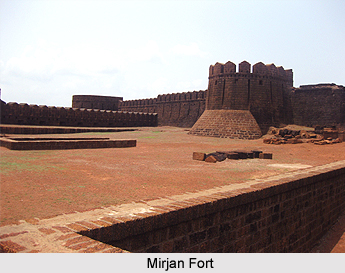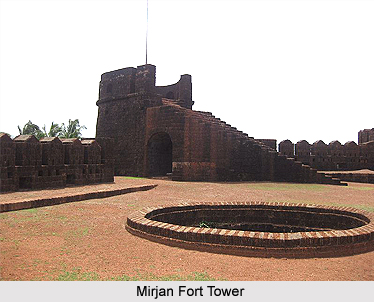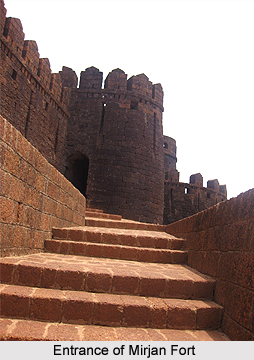 The Mirjan Fort was built in the 16th century and was later renovated during the 17th century. The fortress is situated on the west coast of the district of Uttara Kannada in Karnataka. It has played a significant role in a number of battles throughout the ages. The fort was founded by Queen Chennabhaira Devi of Gersoppa in the 16th century under Vijayanagara Dynasty (Vijayanagar Empire). The geographical coordinates of Mirjan Fort are latitude 14.4888°N and longitude 74.41753°E. The structure is constructed with mud and laterite stones and the architectural style is a mixture of Mughal and Deccan architecture. Presently the fort is developed as a tourist destination and is maintained by the Government of Karnataka.
The Mirjan Fort was built in the 16th century and was later renovated during the 17th century. The fortress is situated on the west coast of the district of Uttara Kannada in Karnataka. It has played a significant role in a number of battles throughout the ages. The fort was founded by Queen Chennabhaira Devi of Gersoppa in the 16th century under Vijayanagara Dynasty (Vijayanagar Empire). The geographical coordinates of Mirjan Fort are latitude 14.4888°N and longitude 74.41753°E. The structure is constructed with mud and laterite stones and the architectural style is a mixture of Mughal and Deccan architecture. Presently the fort is developed as a tourist destination and is maintained by the Government of Karnataka.
History of Mirjan Fort
There are several historical versions related to the construction of Mirjan Fort. According to one version, it was built under the reign of the Nawayath Sultanates during the early 1200. Then later the territory was occupied by the Vijayanagara Empire and the fort was re-built in 1608. Another historical version mentions that Mirjan Fort was constructed by Chennabhaira Devi, the Queen of Gersoppa. She belonged to the Tuluva Saluva dynasty and reigned over the region for a period of 54 years, under the Vijayanagara Empire. The Queen reigned over South Goa, South Kanara (Dakshina Kannada) district and North Kanara (Uttara Kannada) district. These territories included various ports like Karwar, Honnavar, Mirjan, Bidnoor and Malpe. Pepper was exported to Europe from these ports. Thus Queen Chennabhaira Devi was popularly known as the Pepper Queen. Later she resided in the safety of Mirjan Fort on an island in the Sharavati River after the Battle of Talikota.
 Another version is that Sherif Ul Mulk, a dignified and noble person from Bijapur, built the Mirjan Fort. It was constructed as a line of defence in order to defend the Kumta fort and the town of Kumta. In 1608, Mirjan Fort was renovated and refurbished on the south-east coastal part of Tadri creek. Other historical sources state the fort was erected by the rulers of the Vijayanagara Empire. However, the fort was later occupied by the Bijapur sultans. Later in 1676, Queen Chennamma of the Keladi dynasty ruled over the territory of Mirjan. During the 17th century, the Keladi dynasty reigned over the region of Kanara, located towards the south of Mirjan. Their capital was established at Bednur.
Another version is that Sherif Ul Mulk, a dignified and noble person from Bijapur, built the Mirjan Fort. It was constructed as a line of defence in order to defend the Kumta fort and the town of Kumta. In 1608, Mirjan Fort was renovated and refurbished on the south-east coastal part of Tadri creek. Other historical sources state the fort was erected by the rulers of the Vijayanagara Empire. However, the fort was later occupied by the Bijapur sultans. Later in 1676, Queen Chennamma of the Keladi dynasty ruled over the territory of Mirjan. During the 17th century, the Keladi dynasty reigned over the region of Kanara, located towards the south of Mirjan. Their capital was established at Bednur.
After the death of Basappa Naik who was the final ruler of Bednur, the Mirjan Fort was captured by the Maratha Empire in 1757. Later in March 1784 the fortress was seized by the forces of the British East India Company under the leadership of Major Torriano.
Location of Mirjan Fort
 Mirjan Fort is situated on the banks of the Aganashini River, a tributary of the river Sharavathi. It is located on the Tadri creek on the bend of the river. A series of broad steps lead to the inner part of the fort. The fortress is located in the vicinity of the Mirjan village, near Kumta.
Mirjan Fort is situated on the banks of the Aganashini River, a tributary of the river Sharavathi. It is located on the Tadri creek on the bend of the river. A series of broad steps lead to the inner part of the fort. The fortress is located in the vicinity of the Mirjan village, near Kumta.
Architecture of Mirjan Fort
The Mirjan Fort is mainly constructed with laterite stones and covers a total area of 10 acres. The structure consists of bastions and high walls. It has four gateways which include one primary entrance and three subsidiary gateways. The fort is bounded by a circular moat which was utilized as a defensive measure. There are also several well in the fort that are interconnected with the moat. Each of the gateways contains wide stairs that lead up to the interior of the building. The Mirjan Fort is double-walled and includes high turrets and weapon platforms on the bastions. There are also several sculptures of Hindu deities inside the fort.
During the rule of the British Empire in India, the fort was properly maintained. But it suffered heavy damages after the independence of India on 15th August 1947. At present, the fortress is in a ruined state. However the structure is being renovated and modified by the Archaeological Survey of India (ASI). Fortification of the northern bastion has been restored with the stones available in the region. During 2001, a major restoration work was carried out by the Indian Government. Accumulated debris was removed from various areas and the ruined potions of the walls and ramparts were renovated with laterite stones. The fort is currently open to tourists and visitors.



















